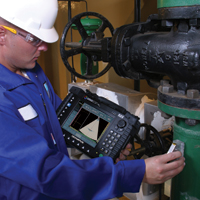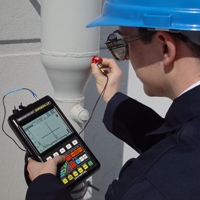Imaging Basics - Introduction
Both conventional and phased array ultrasonic instruments utilize high frequency sound waves to check the internal structure of a test piece or measure its thickness, and both rely on the same basic laws of physics that govern sound wave propagation. Similar concepts are employed in both ultrasonic technologies to present ultrasonic data.
Conventional ultrasonic instruments for NDT commonly consist of either a single active element that both generates and receives high frequency sound waves, or two paired elements, one for transmitting and one for receiving. A typical instrument consists of a single channel pulser and receiver generates and receives an ultrasonic signal, with an integrated digital acquisition system which is coordinated with an onboard display and measurement module. In more advanced units multiple pulser receiver channels can be used with a group of transducers to increase zone of coverage for evaluating different depths or flaw orientations and can further provide alarm outputs. In more advanced systems, conventional ultrasonics can be integrated with positional encoders, controllers and software as part of an imaging system.
Phased array instruments, on the other hand, are naturally multi-channel as they need to provide excitation patterns (focal laws) to transducer assemblies with from 16 to as many as 256 elements. Unlike conventional flaw detectors, phased array systems can sweep a sound beam from one probe through a range of refracted angles, along a linear path, or dynamically focus at a number of different depths, thus increasing both flexibility and capability in inspection setups. This added ability to generate multiple transducer paths within one probe adds a powerful advantage in detection and naturally adds the ability to "visualize" an inspection by creating an image of the inspection zone. Phased array imaging provides the user with the ability to see relative point to point changes and multi-angular defect responses, which can assist in flaw discrimination and sizing. While this may seem inherently complex, it can actually simplify expanding inspection coverage with increased detection by eliminating the complex fixtures and multiple transducers that are often required by conventional UT inspection methods.
The following sections will further explain the basic formats for conventional and phased array data presentation.
Continue on to
Phased Array Scans >>

